(Updated Dec 7, 2024) I’ve tested dozens of organic pillows over the years, and I’ve finally found the best brands you can trust to make the safest pillows that feel amazing. In this comprehensive non-toxic pillow guide, we’ll be providing detailed reviews and comparisons of each pillow, as well as pointing out the distinctions that might be relevant to your personal needs. Plus, we’ll also cover the healthiest pillow fillings, what toxins you want to avoid, and the best organic pillow brands to know.
And the great thing about US brands is most offer risk free trials, so you can try the pillow first and return it if it’s not for you! In a nutshell, I found that Avocado Organic Pillow and Soaring Hearts Latex & Wool Pillow are the absolute best for side sleepers, while Naturepedic Organic Cotton Pillow is the best non toxic pillow for back sleepers.
Table of Contents
Toxins Found in Pillows
If you’re wondering whether toxins are lurking in your pillows, the answer is yes sadly! Chemicals commonly found in pillows are often used for various purposes such as flame resistance, durability, and comfort enhancement.
- Flame Retardants: Many conventional pillows contain flame retardant chemicals like polybrominated diphenyl ethers (PBDEs) or chlorinated Tris. These chemicals have been linked to various health issues and can release toxic gases when heated.
- Formaldehyde: Some pillows may contain formaldehyde, a known carcinogen and respiratory irritant. Formaldehyde is sometimes used in foam pillows or as a preservative in cotton or synthetic fabrics.
- Volatile Organic Compounds (VOCs): Some pillows can emit VOCs, such as benzene, toluene, and styrene. These chemicals can contribute to indoor air pollution and cause respiratory problems, headaches, or dizziness.
- Allergenic materials: People with allergies should avoid pillows made with common allergens like down feathers or certain synthetic fibers. These materials can trigger allergic reactions and respiratory issues.
- PVC or vinyl materials: Pillows with PVC or vinyl covers may contain phthalates, which can disrupt hormone function and are considered harmful to human health.
One common chemical found in pillows is polyurethane foam. While this material provides a plush and supportive feel, it can release volatile organic compounds (VOCs) into the air.
Pillows may contain phthalates, a group of chemicals commonly used to increase flexibility and durability in plastics. Phthalates have been associated with hormone disruption, reproductive issues, and developmental problems in children.
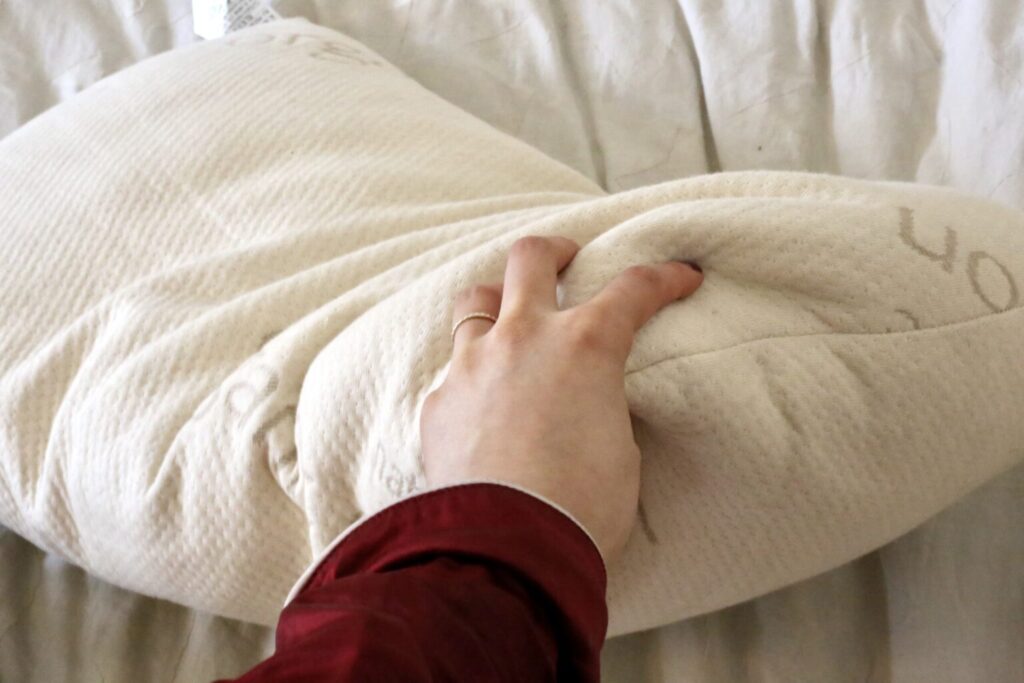
I Tried Naturepedic PLA Pillow
Naturepedic’s PLA Pillow is one of my personal favorites because it’s very soft and a lot thinner than all the other organic pillows I’ve tried. This one is made with non-toxic, sustainable fibers derived entirely from sugarcane, a 100% renewable resource. PLA is a more affordable alternative to certified organic fibers, but it’s still a safe option and just as comfy!
After testing so many non-toxic pillows, I would say nearly all of them are made to be quite lofty and bouncy to mimic the plush feeling of hotel pillows. I enjoy lofty pillows on some nights, but a thinner pillow actually keeps my spine, neck and head correctly aligned, which is crucial to the quality of my sleep. So, if you’re looking for a flatter yet still nicely cushioned pillow or you’re a back sleeper, my top pick is Naturepedic’s PLA pillow. Plus, it’s so affordable compared to other non-toxic pillows, which can easily range between $100-$200 each!
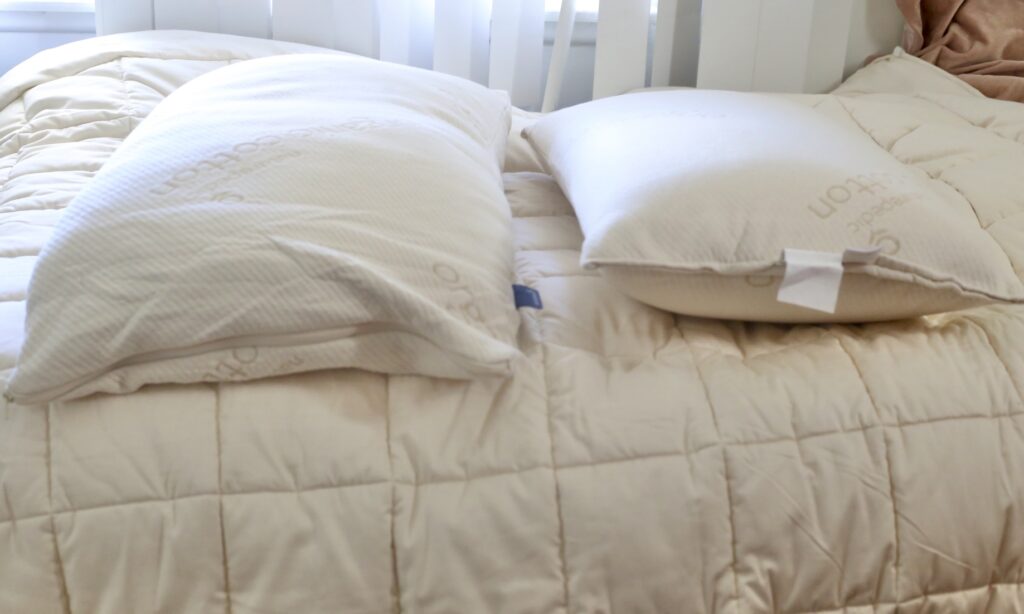
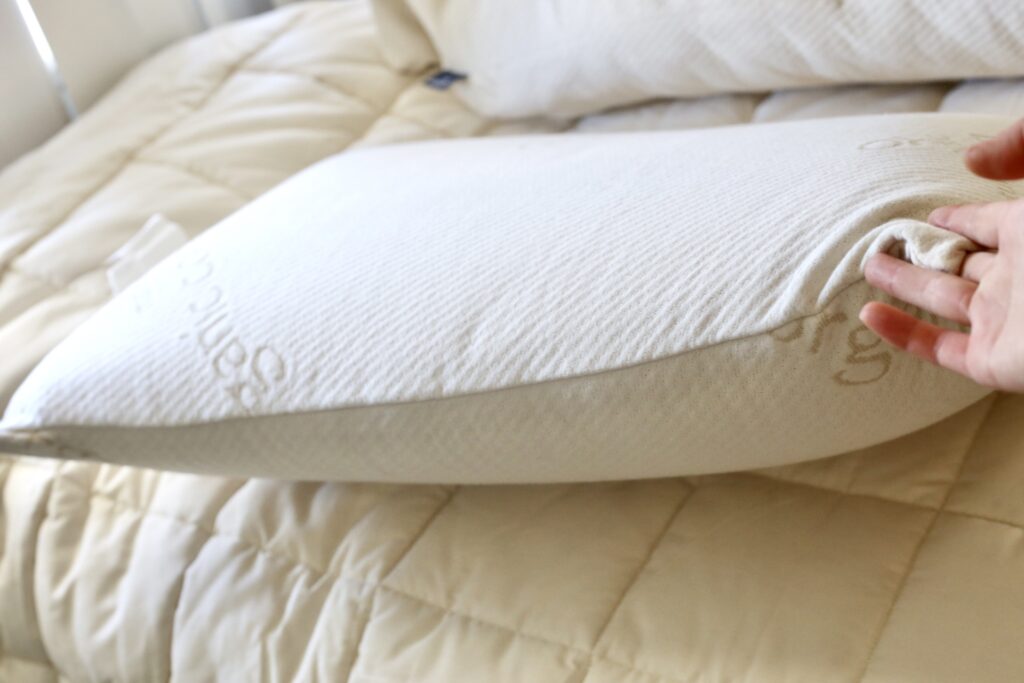
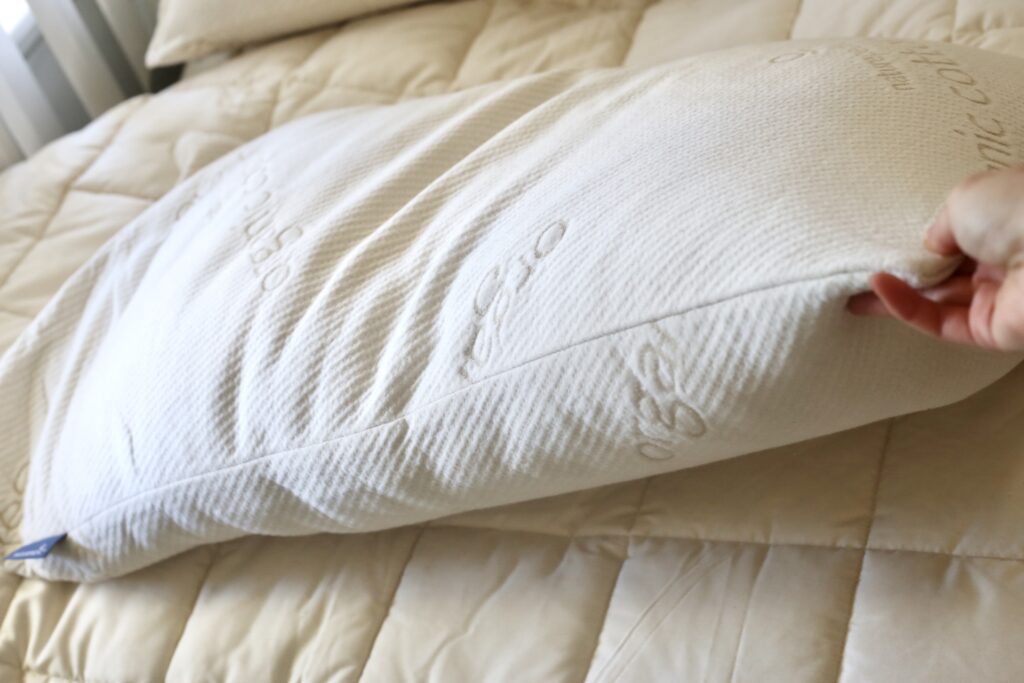
Materials:
- Fill: Pure plant-based PLA batting on the inside (derived entirely from non-GMO sugarcane)
- Cover: organic cotton
How It Feels:
- Feels very soft
- Great if you want a soft pillow your head sinks into
- This is a flatter, thinner pillow if you find most pillows are too lofty or bouncy for you
Price: $79
SAVE: Discount code OBL saves 15% sitewide
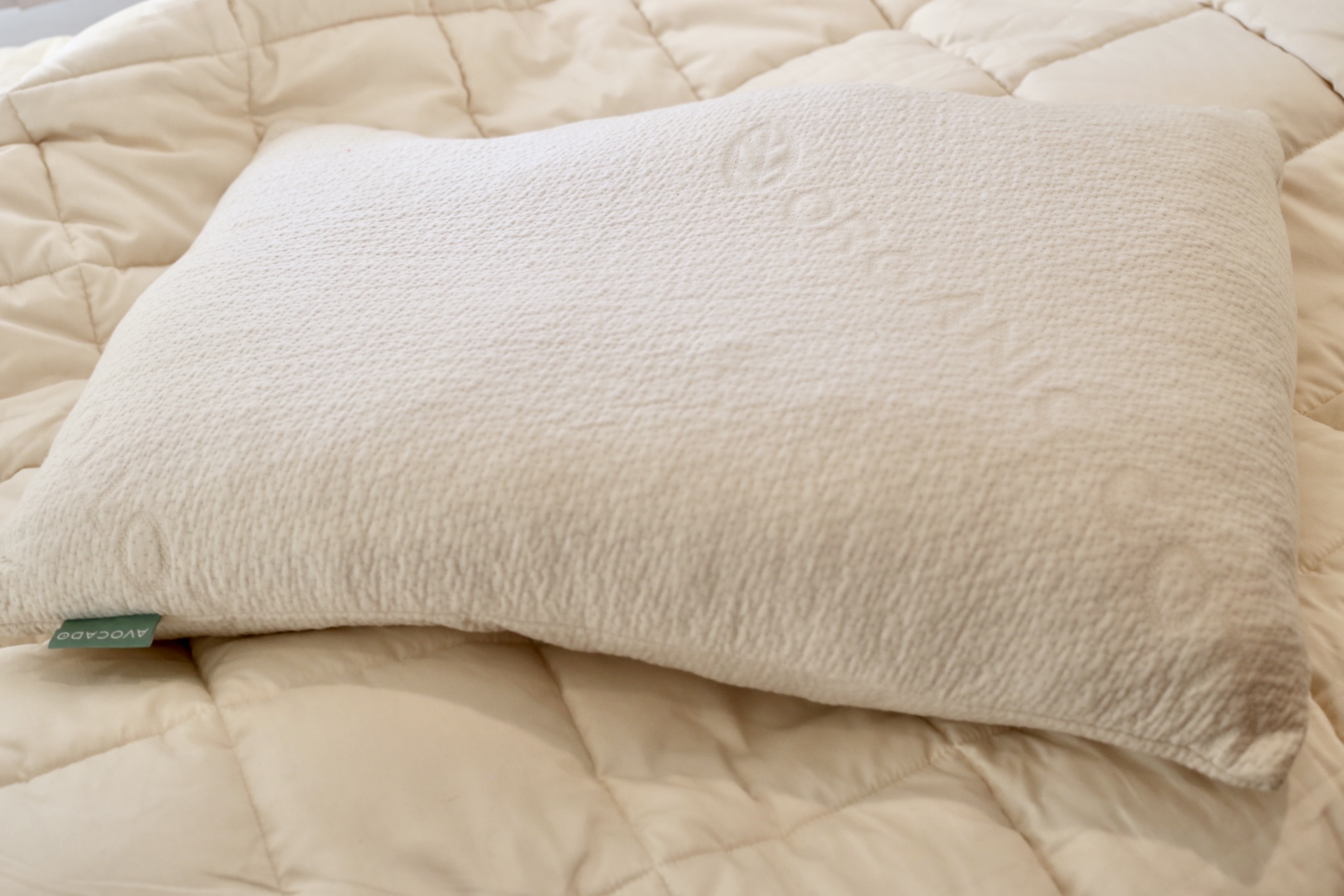
I tried Avocado Luxury Organic Plush Pillow
I noticed Avocado’s organic pillow doesn’t come as fluffy as other pillow brands but they offer an extra pouch of filling so you can adjust it your liking. This is one of the most luxurious organic pillows on the market and has a super plush yet supportive feel. It’s not overly lofty or bouncy but still has a decent amount of cushioning.
Avocado’s organic pillow has an impressive blend of four different natural fibers of latex, mohair, wool and silk along with a GOTS certified organic cotton cover.
Materials:
- Fill: Talalay latex core surrounded by a top and bottom layer of 700 grams of mohair, wool, and silk blends.
- Cover: 100% GOTS-certified organic cotton
How It Feels:
- Medium-soft pillow for more neck, head, and shoulder support
- Plush and soft with some firmness
- Feels luxurious
Prices:
- Luxury Organic Plush Pillow $229
- Green Pillow $109
- Molded Latex Pillow $129
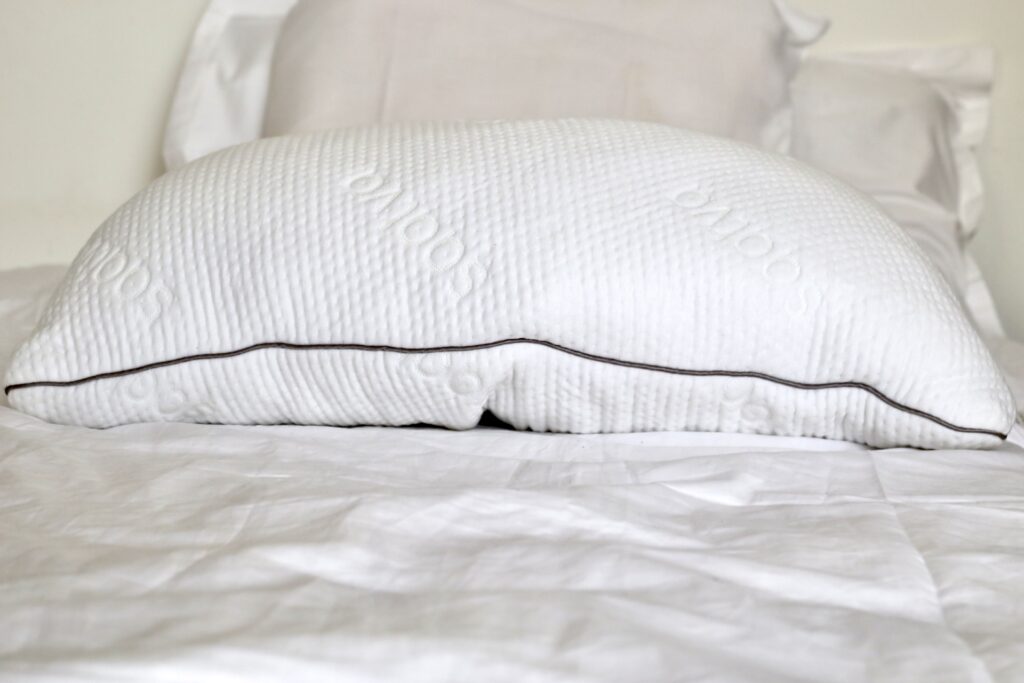
I Tried Saatva Cloud Memory Foam Pillow
I discovered through testing this pillow that CertiPUR-US certified memory foam is a bit more comfortable for me than organic cotton, natural kapok or purely latex pillows. Once the pillow sets from sleeping in it for a few nights, it truly molds and contours to your head and feels comfortable.
My partner is a memory foam pillow man, so we both tested the Saatva Cloud Memory Foam Pillow. I was surprised by how heavy (and hefty) this pillow feels. My partner found the quality and feel of the Saatva pillow to be excellent, but it was too lofty for him and caused some neck pain.
He prefers something much firmer and flatter. I, on the other hand, found their memory foam pillow to feel very dense at first, but once the foam set after a few nights of use, I could sleep very comfortably in this. But if you find that you need a flat, level memory foam pillow Saatva’s would probably be too high for you.
Materials:
- Fill: 100% CertiPUR-US® certified memory foams and latex
- Cover: organic cotton
How It Feels:
- Contouring, dense and conforms to head shape like memory foam
- Feels luxurious and very high quality
- Safer alternative for memory foam pillow lovers
- Pillow is a little too high for my partner but perfect for me after a few nights of sleep when the memory foam set
- I wouldn’t recommend this for back sleepers as it’s quite thick and can cause discomfort if it’s too high for you
Prices:
- Cloud Memory Foam Pillow $135
- Latex Pillow $165
- Down Alternative Pillow $115
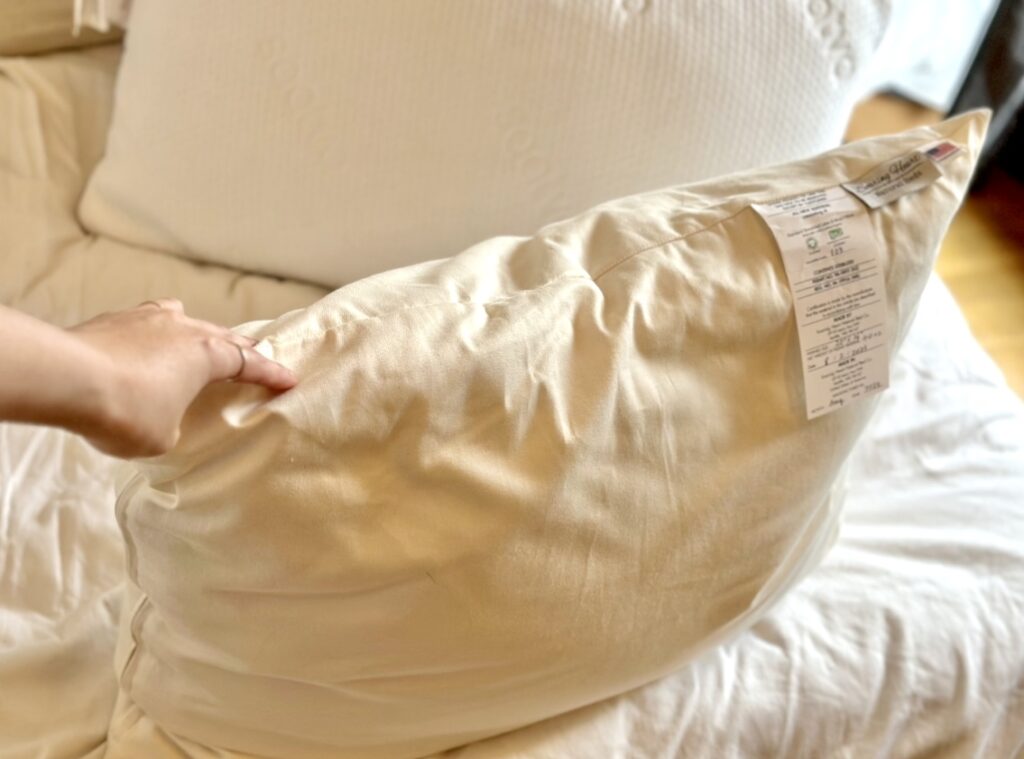
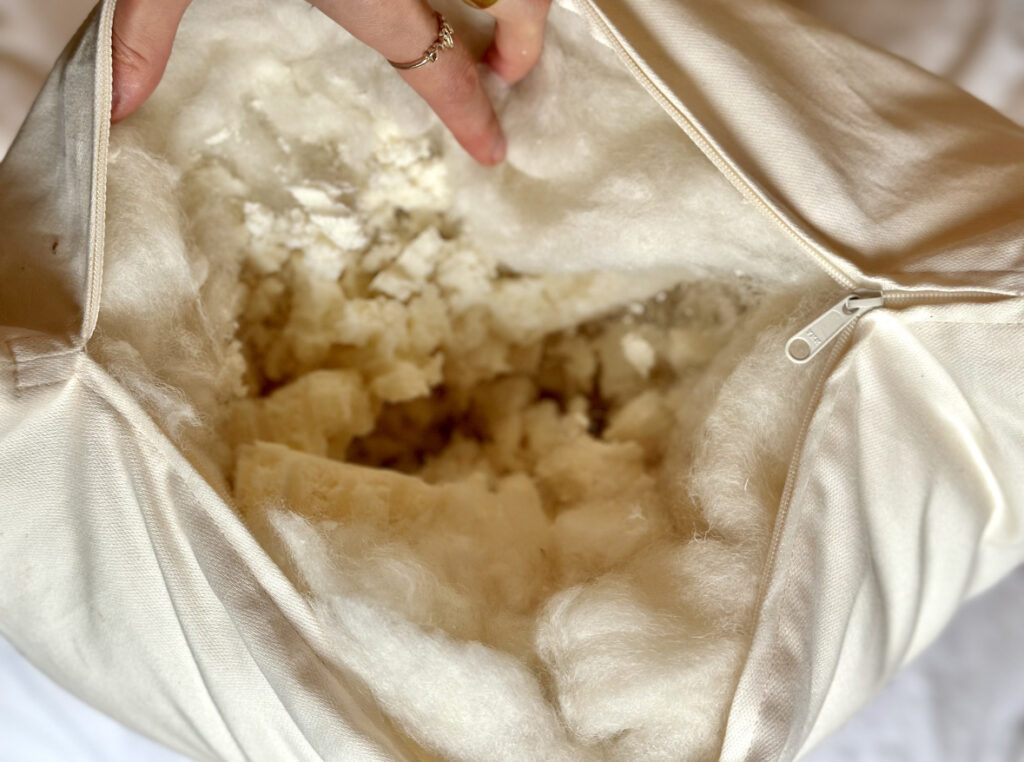
I Tried Soaring Heart Organic Shredded Latex & Wool Pillow
The Soaring Heart Organic Shredded Latex & Wool Pillow has a much more handcrafted feel than the other brands mentioned in this article and feels lofty and plump yet supportive. Your head will sink into this pillow but feel cushioned and supported at the same time.
This is one of my favorite entirely organic pillows and I’d recommend it for side sleepers and combo sleepers. The shredded latex gives it a buoyant feel while the wool adds to its softness.
I love that Soaring Heart handcrafts their organic pillows (and mattress that I also use – see full review here!) right in Seattle with the utmost care and attention to quality and detail.
It comes with a zipper, so I was able to remove some of the filling to make it feel exactly to my liking. I always recommend getting a pillow with a zipper because even the softest filling can become dense and uncomfortable if there’s too much of it.
Materials:
- Fill: Organic wool and organic latex
- Cover: Organic cotton
How It Feels:
- Lofty and plump
- Soft yet supportive
- Great for side sleepers
Price: $149 (Use OBL for 5% off)
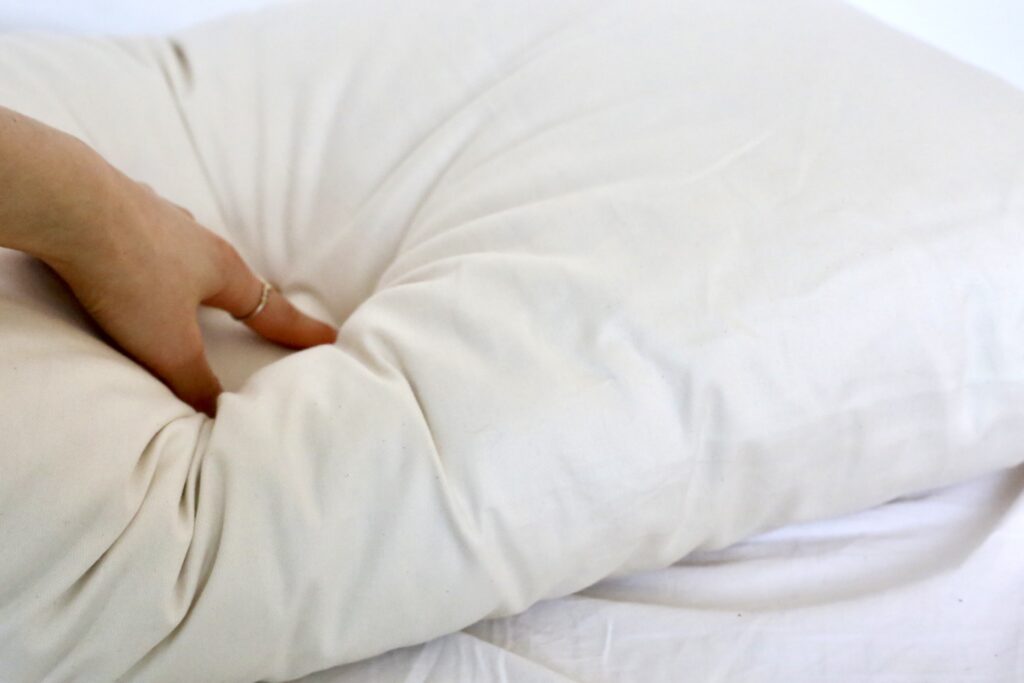
I Tried Soaring Heart Natural Kapok Pillow
Another non toxic pillow I tested was the Soaring Heart Natural Kapok Pillow. This pillow is excellent for side sleepers and can be customized to work just as well for back sleepers and combo sleepers.
Compared to other organic pillows, this felt a bit firmer initially because it comes with a TON of filling (28 oz). Thankfully, Soaring Heart pillows come with a zipper so I was able to remove a third of the batting and customize it to be way more comfortable.
Natural kapok IS a super fluffy soft material, but when there’s a lot of batting packed together it tends be overly firm and plump for me.
It’s great that Soaring Heart overfill its, so those who like a super lofty and supportive pillow can still have that, and those who want a softer airier pillow can customize it to their liking. Once I reduced the amount of filling my head truly felt like it was sinking into a soft cloud. Personally, I still find their organic shredded latex & wool pillow more comfortable for me.
In the photo below, the pillow on the left is filled with kapok and the one on the right with shredded latex and wool.
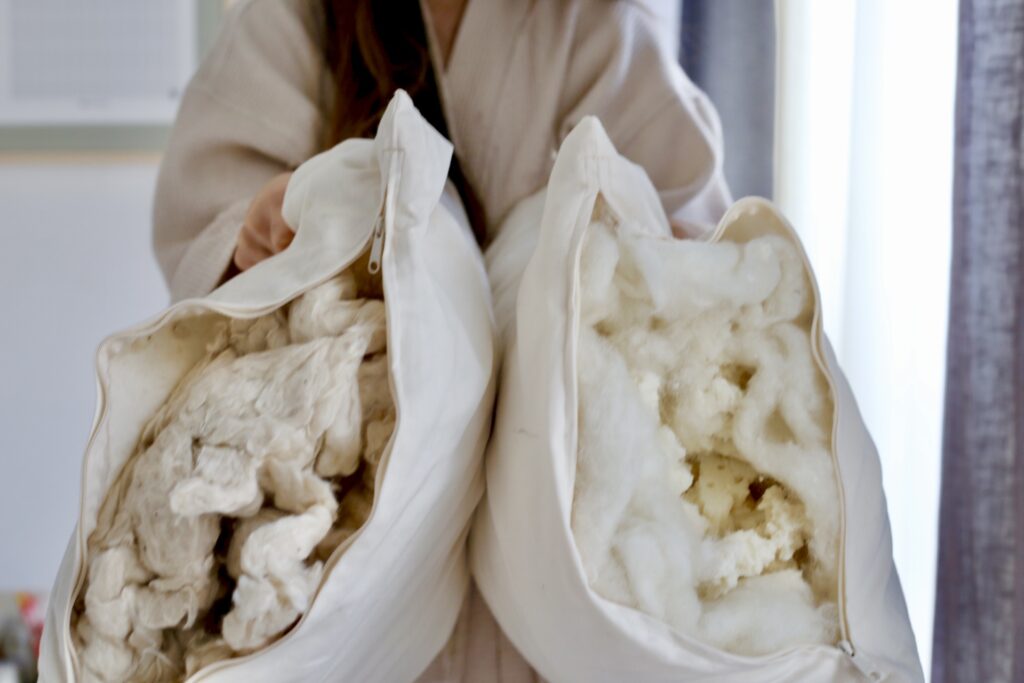
Materials:
- Fill: Natural, untreated kapok fibers
- Cover: Organic cotton
How It Feels:
- Lots of support, plump and lifted due to it coming filled to the max (has zipper to remove/add batting)
- Lofty yet soft
Price: $124 (Use OBL for 5% off)
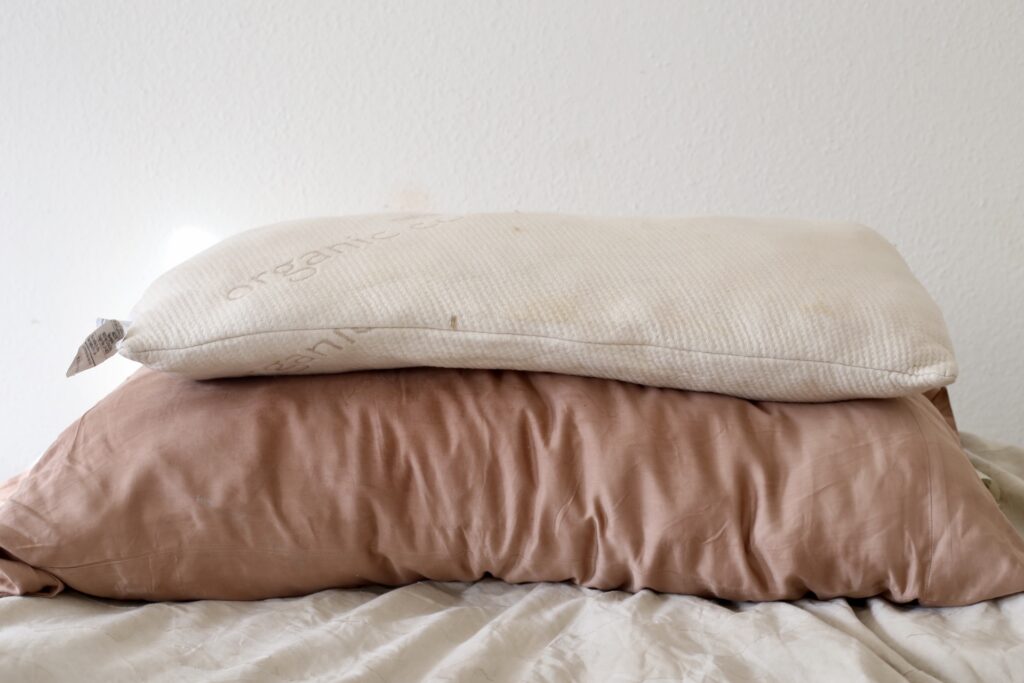
I Tried Buffy Natural Cloud Pillow
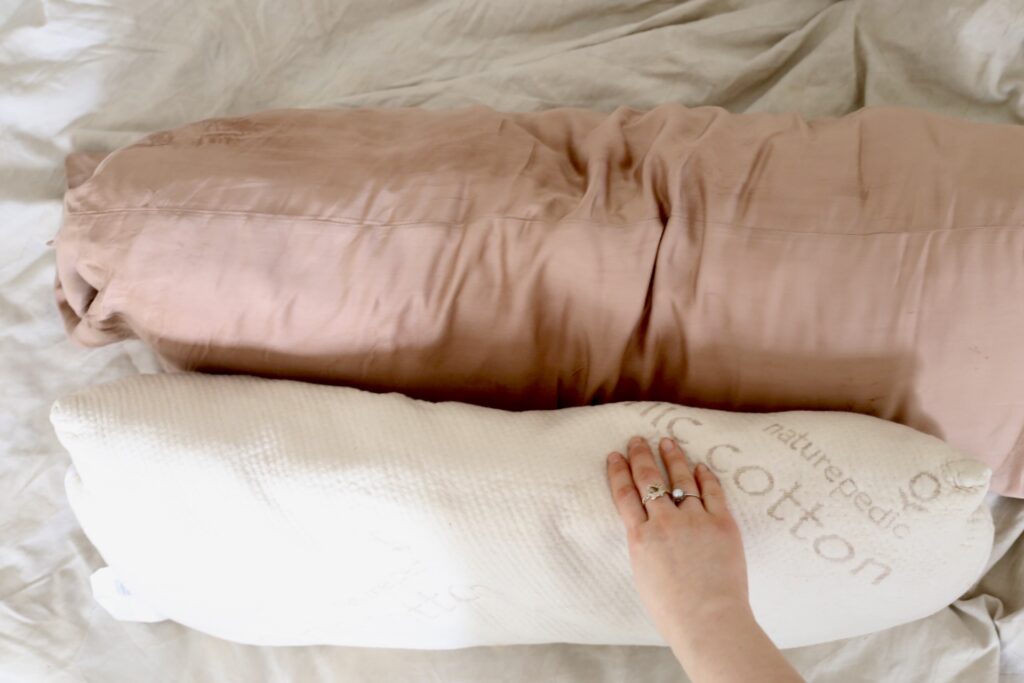
Buffy Cloud Pillow in medium firmness is a VERY plump and lofty pillow, and while it’s not organic it’s made with recycled plastic bottles and Tencel. It truly feels like your head is resting on a big poofy cloud.
You can see in the image that the Buffy pillow above is considerably loftier than my Naturepedic pillow. It does have a zipper so you can remove batting to make it less lofty.
Plus, you can order these in different firmness levels of soft, medium and medium firm. If you’re not into poofy pillows I would go down a level and get the “soft” or if you’re unsure, go for the medium then remove some of the filling to your liking.
Materials:
- Fill: 100% GRS-certified, BPA-free, recycled PET (recycles 24+ plastic bottle)
- Cover: 300 single-ply thread count sateen weave TENCEL™ lyocell shell
How It Feels:
- Very lofty, fluffy and ideal for side sleepers
- Big and plump
- Pillow height a little too high and occasionally caused some neck discomfort for back sleeper (remove filling in this case)
- Gets a little lumpy after a few years of use but overall retains its shape well
The Buffy Cloud Pillow is customizable when ordering with soft, medium or firm firmness.
Prices:
- Cloud Pillow $50
- Wiggle Pillow $109

I Tried White Lotus Home Organic Pillows
White Lotus Home has the largest variety of fills to choose from (cotton, kapok, wool, shredded latex, buckwool, buckwheat). I’ve tested White Lotus Home’s organic cotton pillow and green cotton pillows.
Their green cotton pillow is a more affordable option to their organic cotton products with the only difference being it isn’t certified organic. These are extremely supportive and on the firm side (I strongly recommend getting the zipper option so you can remove/add filling to suit your preference).
Materials:
- Fill: sustainably grown GOTS-Certified Organic Cotton
- Cover: Organic Sateen Cotton
Prices:
- Organic Cotton Pillow $115
- Green Pillow $73
- Kapok Pillow $78
- Wool Pillow $114
- Natural Shredded Latex Pillow $148
SAVE: Discount code OBL saves 15% at White Lotus Home
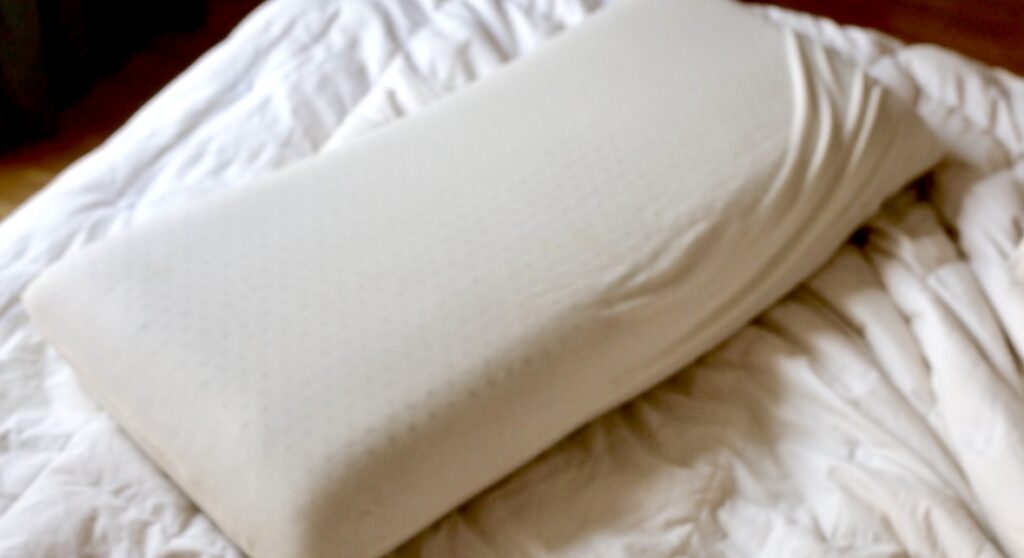
I Tried My Green Mattress Charcoal-Infused Organic Latex Pillow
Materials:
- Fill: Eco-institute and FSC certified Dunlop Latex
- Cover: GOTS Certified Organic Cotton
How It Feels:
- Firm contouring feel
- Least favorite feel as solid latex-only is too firm personally, but the large size is great as a body pillow
Price: $99
Check out: 12 Best Organic Sheets for a Healthy Bed
Should Pillows be Organic?
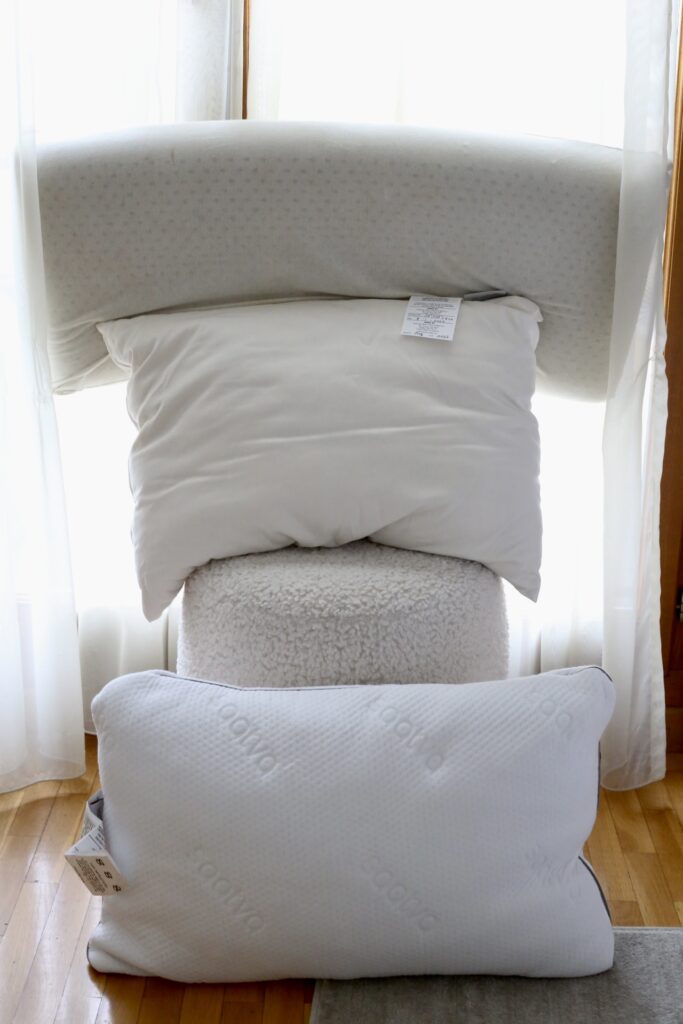
Why is it important to switch over to a non toxic pillow? We sleep 8 hours a night buried in our pillows, which is about as intimate as it gets. You want to avoid being in such close contact with harmful toxins, especially when you consider the amount of hours and days over the course of our lives we spend sleeping.
Harmful chemicals commonly found in pillows, such as flame retardants, phthalates, and formaldehyde, have been linked to respiratory issues and allergic reactions. Many pillows on the market contain volatile organic compounds (VOCs), which are emitted as gases and can originate from various sources such as fabric treatments, adhesives and flame retardants.
When choosing a non toxic pillow, be sure to look for certifications like Global Organic Textile Standard (GOTS) or CertiPUR-US, which ensure the materials are free from pesticides, herbicides and other harmful chemicals.
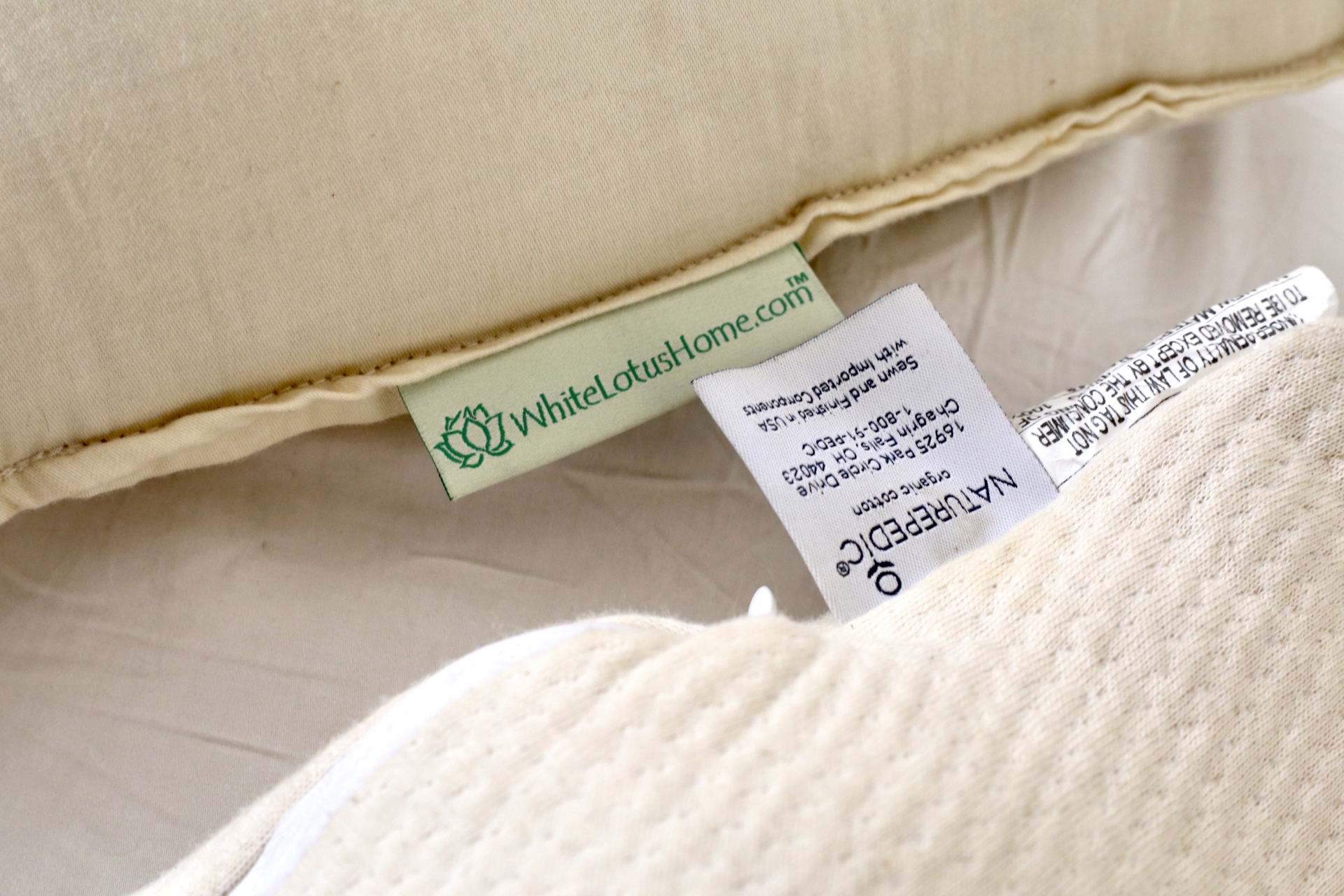
What is the healthiest type of pillow?
The absolute healthiest pillow filling is GOTS certified organic fibers like certified organic wool and organic cotton.
The certification proves they went through a rigorous testing process and that no pesticides or harmful chemicals were used in the making of the material.
These pillows can get expensive, so if that’s the case just be sure to look for one made with all natural or plant-based fibers without any petroleum.
The most common organic materials used to fill non-toxic pillows are latex, kapok, wool, cotton and even buckwheat. Some even combine a few different natural fibers like organic latex plus wool or kapok and latex to create different feels.
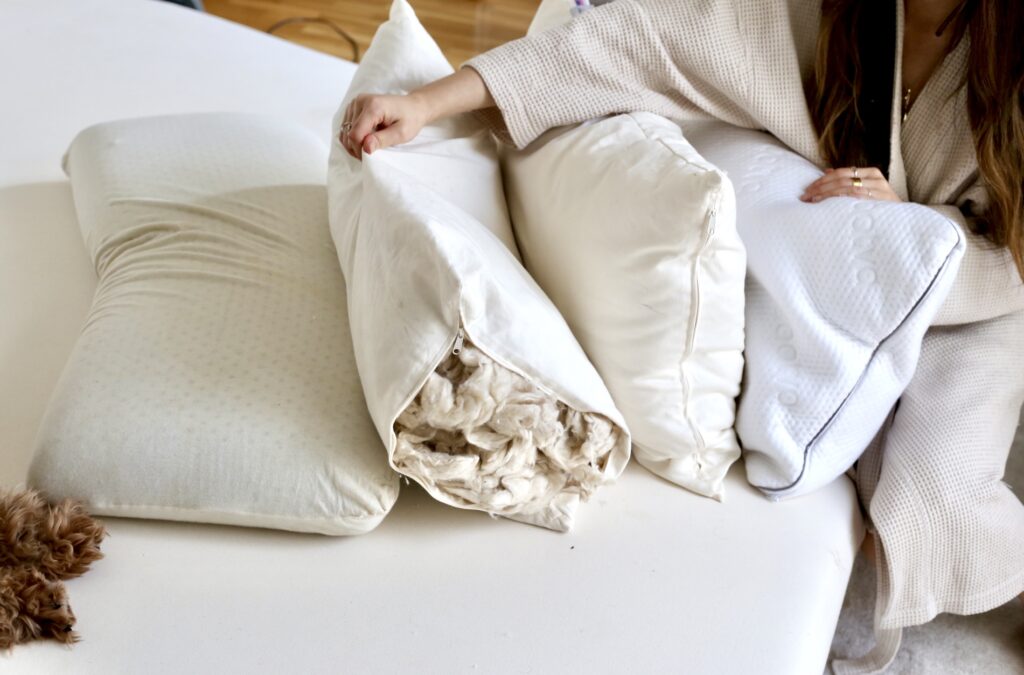
Materials in Non-Toxic Pillows (and how each feels!)
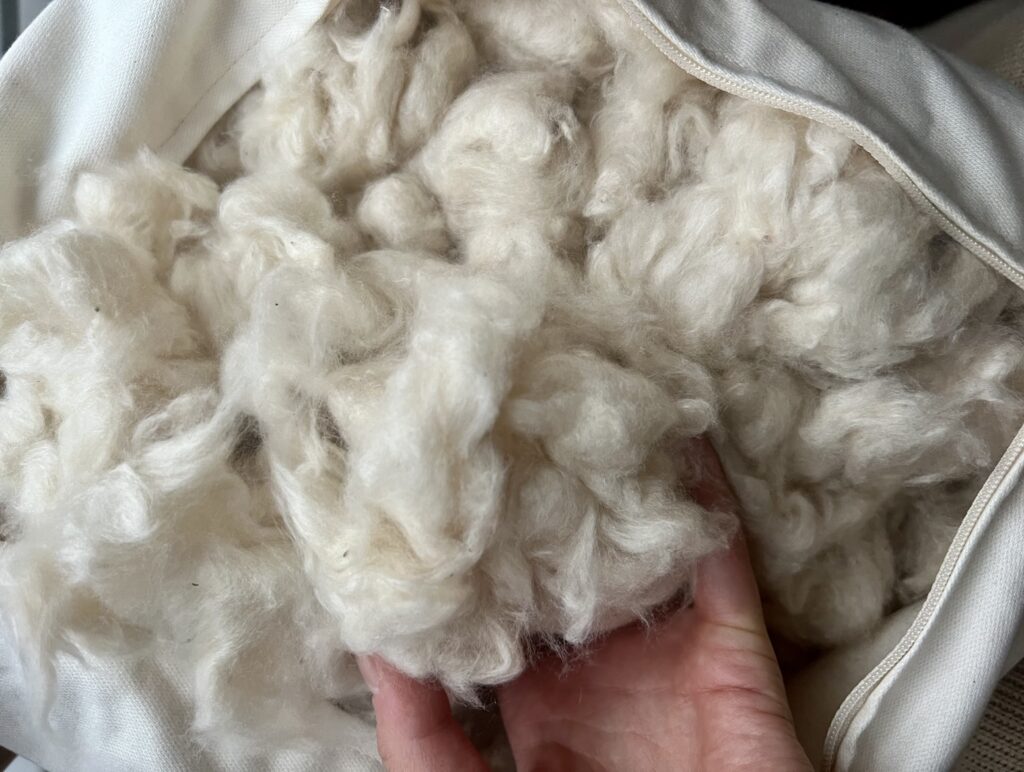
- Molded Latex: This is a natural foam made from the sap of the hevea-brasilienis rubber tree. Molded latex is great for its durability and temperature control but can be too firm for some people.
- Shredded Latex: This is natural latex shredded into smaller pieces. It’s great for those who like a soft pillow. Your head will feel more like it’s sinking into shredded latex with a bit of bounce and resiliency.
- Kapok: Kapok is a softer alternative to down with a fluffy feeling that’s made from the kapok tree. Your head will also feel like it’s sinking into a kapok pillow with a bit more even support.
- Wool: Wool also makes for a very soft pillow ideal for stomach sleepers & back sleepers.
- Cotton: Organic Cotton pillows are usually firmer, so I recommend getting one that’s zippered so you can remove batting if necessary.
- Buckwheat hull: Buckwheat pillows are made with shells derived from buckwheat plants and feel like a firm bean bag for your head. This is the firmest type of pillow for people with neck pain. These are much too firm for most people, including myself, and not something I would recommend unless you enjoy sleeping on a bean bag pillow.
- Other non-toxic pillow fillings: recycled plastic bottles, PLA derived from sugarcane, Tencel
What to Look For: 3rd Party Certifications
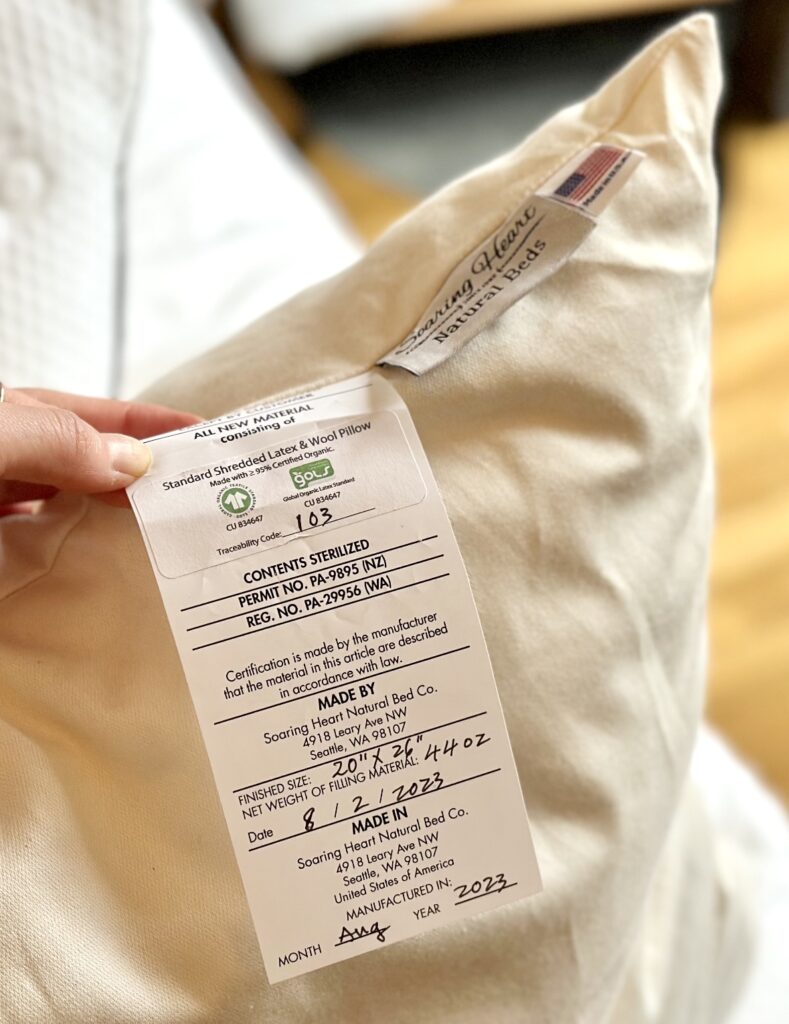
Greenwashing with pillows is more common than you think! That “natural” pillow could still be stuffed with untested polyurethane foam or polyester.
Certifications matter and ensure the pillow is genuinely safe and free from harmful materials. Here are the most important ones to look for:
Global Organic Textile Standard (GOTS): requires that at least 95% of the materials in a pillow are certified organic
Global Organic Latex Standard (GOLS): applies to latex products and requires 95% organic latex
USDA Organic: requires 95% certified organic materials
Certi-Pur US: must pass independent testing every year and be free of harmful compounds
MadeSafe: requires products be free of heavy metals, hazardous flame retardants, pesticides, toxic solvents, VOCs and harmful chemicals (does not test the actual product and only checks the ingredients)
Made in Green by Oeko-Tex (and Standard 100): requires the pillow to meet safety, sustainability and socially responsible working conditions standards
Greenguard Gold: tests for VOC emissions
Cradle to Cradle (c2c): applies only to Talalay latex in pillows and ensures the pillow is sustainable, eco-friendly, socially fair, and safe in terms of materials and chemical processes.
Fair Rubber Association: applies to latex pillows only and ensures the improvement of the working and living conditions of those producing natural latex
ssed without potentially harmful chemicals.
eco-INSTITUT: ensures the pillow is free of VOCs, POPs (persistent organic pollutants), heavy metals, pesticides, formaldehyde, Phthalates, synthetic rubber, phthalates, formaldehyde and acetaldehyde
Read the latest!
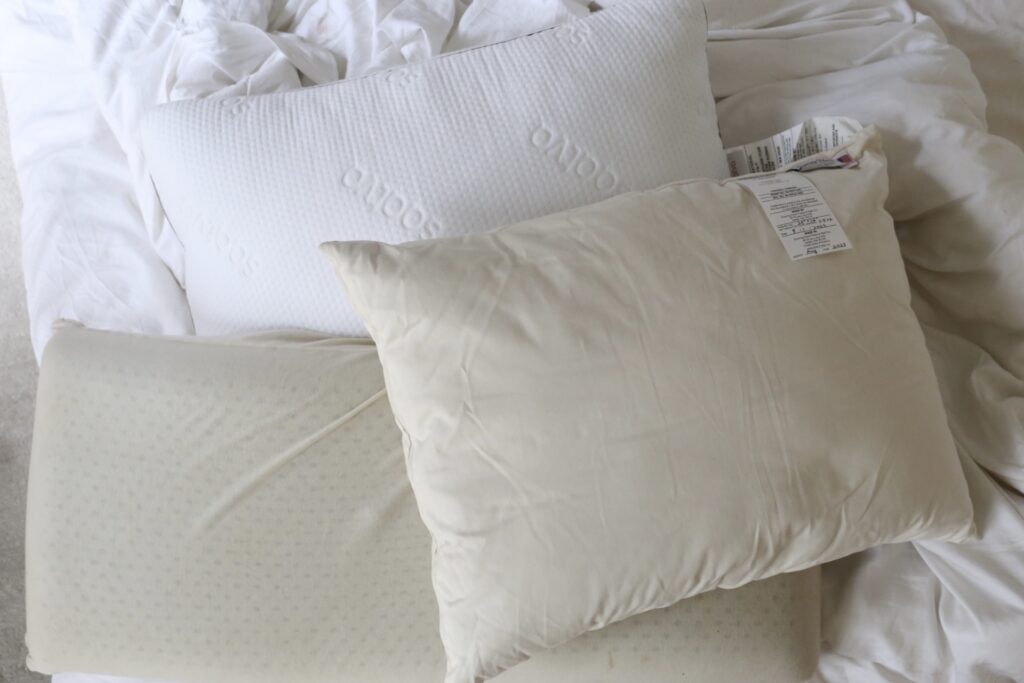
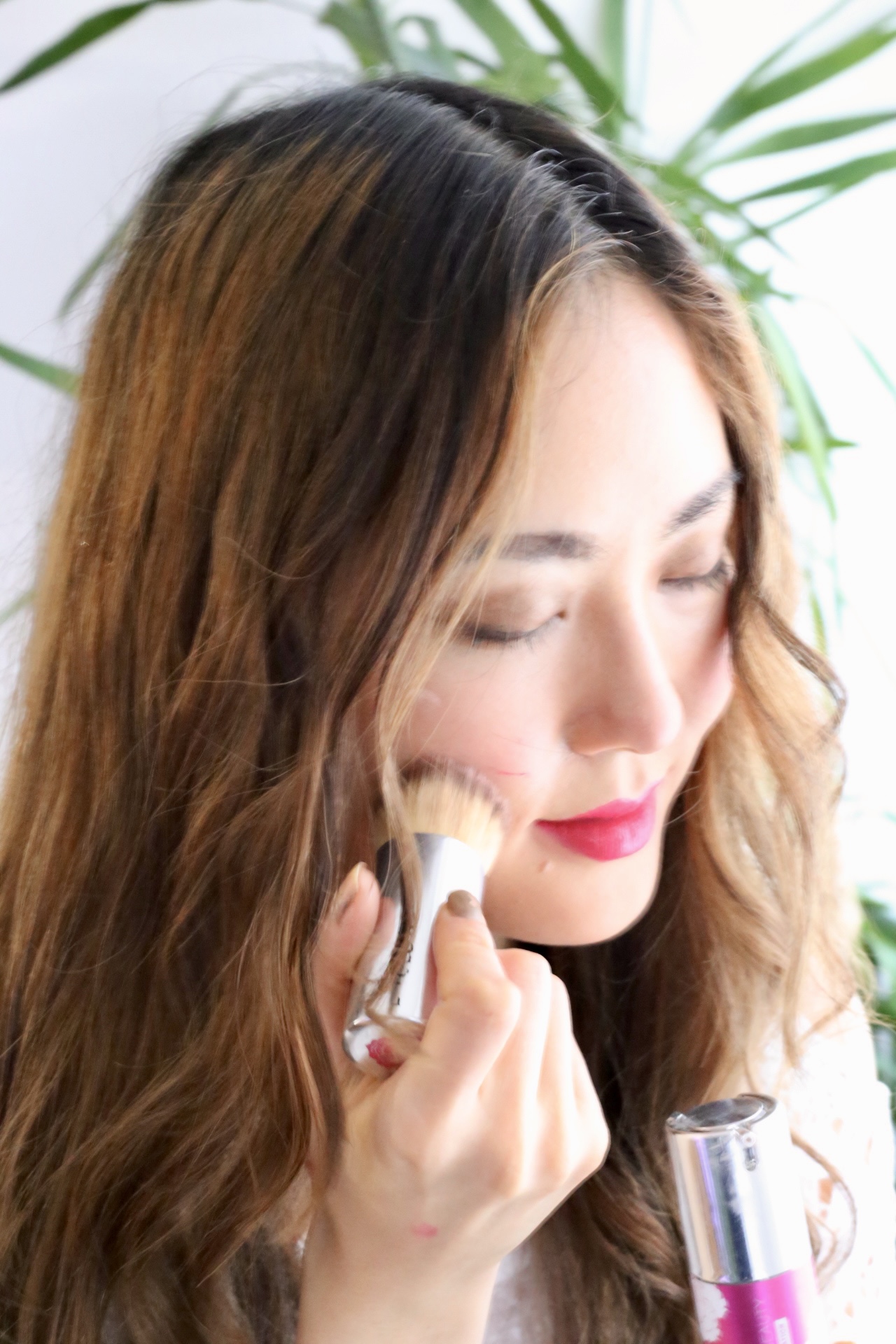
Andrea is a clean beauty expert from Los Angeles, California with 10 years of experience in natural skincare and organic living. She writes for Organic Beauty Lover using her expertise to guide readers in choosing the best clean products. Andrea graduated from the University of Southern California in 2012 and has worked at multiple skincare companies, big and small. Connect with her @organicbeautylover.

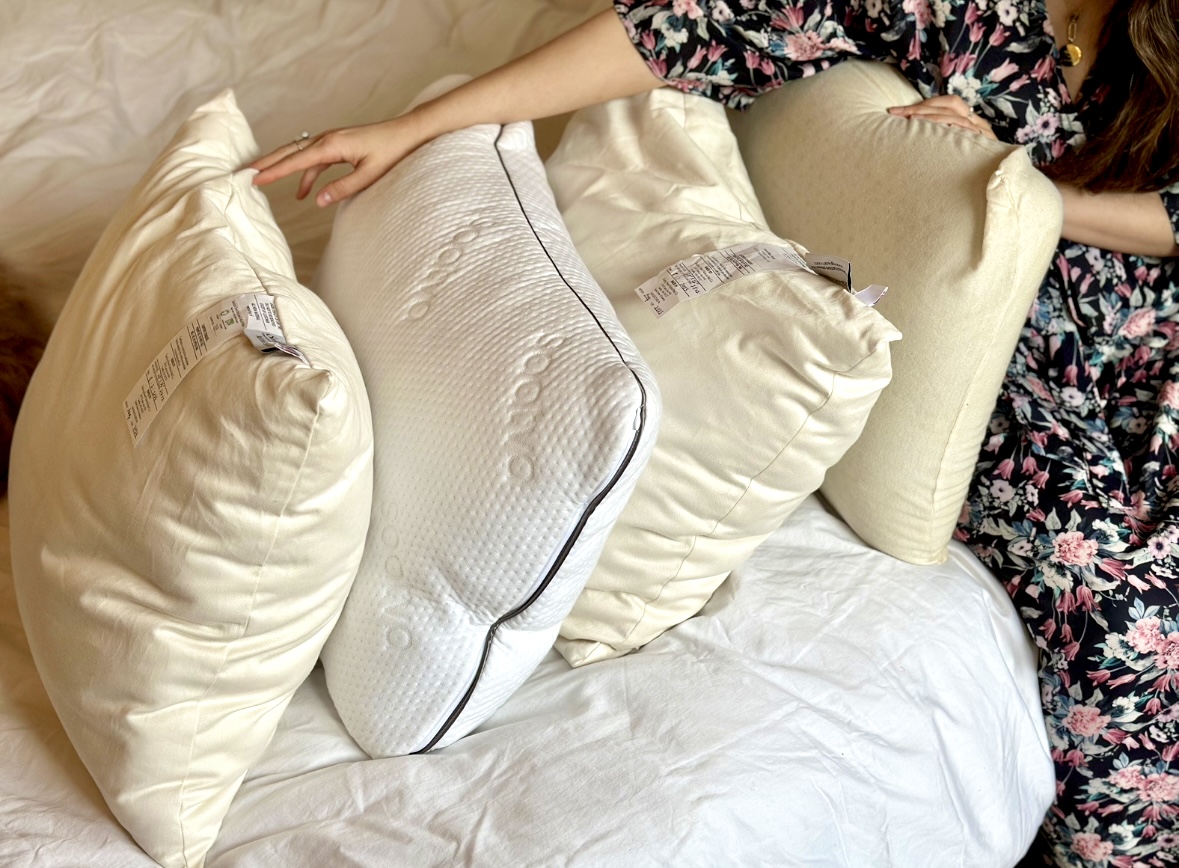

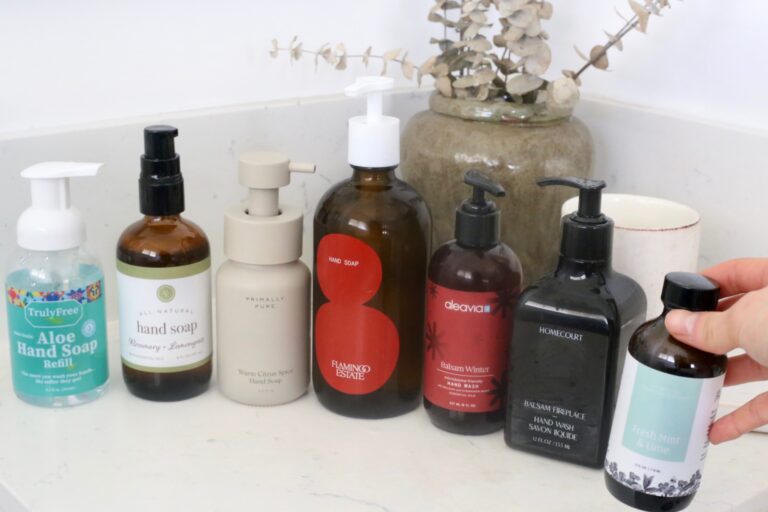

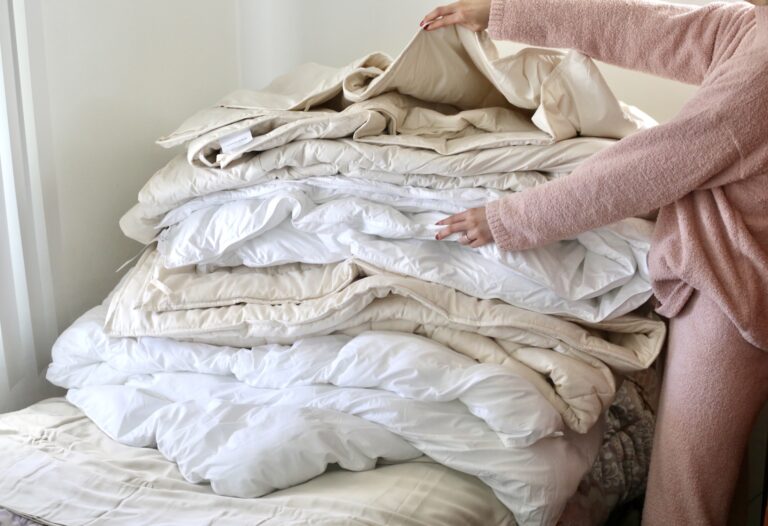
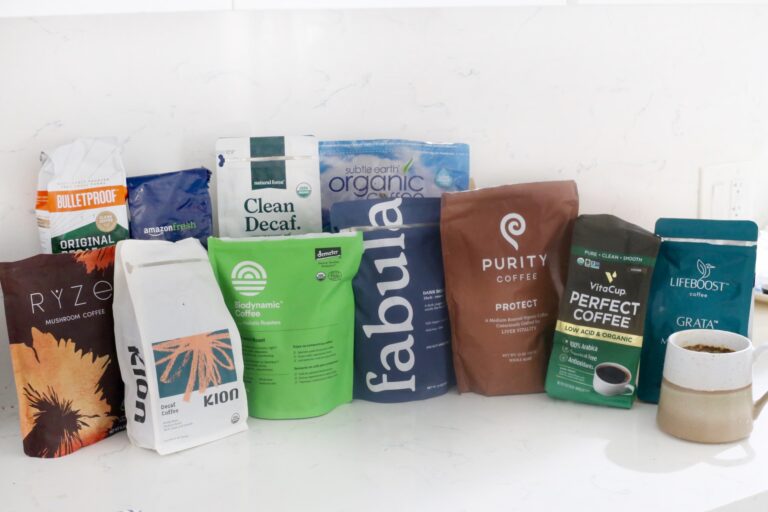

Leave a Reply